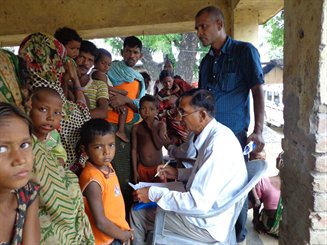REACH PROJECT
The effects of the Rojiroti UK microfinance programme in Bihar on the nutritional status and health of under-five children: a cluster randomised controlled trial.
Need for the research
Child malnutrition remains is a major health concern – underweight is an underlying cause in 45% of all child deaths.
The poorest regions in the Northern states of India, such as Bihar, have the highest level of child malnutrition.
There is a need for evaluating approaches to alleviate child malnutrition. Rojiroti UK microfinance increases the economic resilience of rural communities and may improve nutrition of their children. It may offer an alternative to traditional methods of improving child health and could be readily scaled up to cover the poorest communities over a large region.
Primary research question
- Does the Rojiroti UK microfinance programme, introduced through self help groups (SHGs) for very poor women, reduce the degree of acute malnutrition (measured by weight for height Z score) amongst children under 5 years?
Secondary research questions
- Does Rojiroti UK microfinance improve other anthropometric measures (mid upper arm circumference, height for age Z score, weight for age Z score)?
- Does Rojiroti UK microfinance lead to changes in under 5 mortality?
- Does Rojiroti UK microfinance affect indirect measures of children’s wellbeing, including immunisation rates and school attendance?
- What are the mechanisms through which Rojiroti microfinance affects children’s survival and nutritional status?
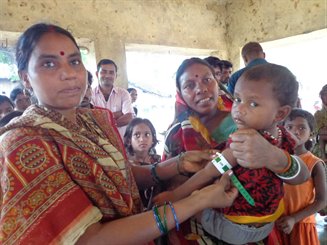
The intervention
Rojiroti UK is an innovative microfinance scheme, aimed at the very poor. Initially, CPSL staff introduce the idea of Self Help Groups (SHGs) to the women and support them in forming their own SHGs. The women are encouraged to contribute their own savings initially (Rs2.5 per week) and expected to attend at least 4 weekly meetings before their savings entitle them to a loan. External funding for loans is administered by CPSL and the group is entitled to receive external loans after 3-6 months. The group members apply to the SHG for loan and if all members agree, the individual can borrow the required amount either from within the groups savings or from CPSL. These loans are usually small (Rs50 for general purpose loans and larger sums for emergency loans). The groups manage their own savings and loan can be requested for any purpose. The participant taking the loan specifies the loan tenure and institutional loans have an interest rate of 18% APR.
CPSL has been highly successful in running Rojiroti UK microfinance schemes amongst the very poor in Northern India since 2001. By 2011, there were around 50,000 Rojiroti UK members (almost all women) in 4,100 SHGs. In the past CPSL have recovered 80-90% of the loans within the time specified by the members.
Research method
The REACH project is designed as a cluster randomised trial.
Participating tolas will be randomised to early or delayed Rojiroti UK microfinance. Tolas will be grouped in pairs so that each tola in a pair is from a similar agro-economic zone and of similar population size and where the tolas are at least 15km apart (to avoid “viral” spread of SHGs).
Informed consent will be taken from the women in the villages by video recording, as trialled in the Pilot Project.
The nutritional outcomes will be measured in all children who are under five years of age at the start of the study and those who are born during the study period. The anthropometric assessments will be performed at the start of the study, at 9 months, at 18months (when the SHGs will be introduced in the control tolas), at 27 months and finally at 36 months.
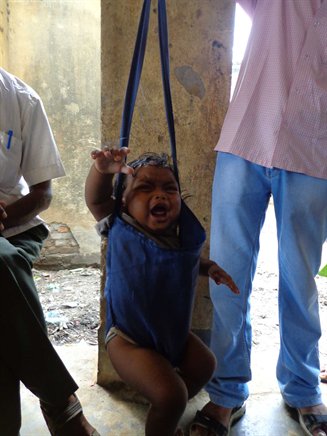
Economic, social and qualitative measures
Two qualitative researchers (an anthropologist and an economist) will explore the following mechanisms through which Rojiroti UK microfinance might affect children’s survival and nutritional status.
They will compare the early and late intervention tolas using a number of social and economic parameters such as,
- Demographics
- Nutrition (exclusive breastfeeding, complementary feeding, food availability)
- Health (immunisation, care-seeking for childhood illnesses, prevention)
- Household income
- Women’s empowerment using the women’s empowerment in agriculture index, a questionnaire, piloted by CPSL in Bihar which collects data on the following:
- demographics (including caste)
- knowledge of household finances
- children’s ages and school attendance
- land ownership and share cropping
- house ownership and condition
- ownership of livestock, domestic appliances, vehicles and agricultural equipment
- use of the Indira Awas (housing) or Janani Surksha (maternity) schemes
- use of local money lender and current debts
- experience of domestic violence
- recent emergency asset sales
Potential impact
There is evidence that conventional nutritional intervention programmes do not favor the marginalized and most poor. Rojiroti UK targets women in this group – 62% are from scheduled castes and 80% are below the poverty line. If the approach is shown to improve nutrition in children , then it may be scaled up further and used alongside nutritional interventional programmes to improve the health and nutrition of the poorest children.
Lessons learned in India may be directly relevant to other low and middle-income countries.
रीच परियोजना
पांच साल से कम उम्र के बच्चों के पोषण की स्थिति और स्वास्थ्य पर बिहार में रोज़ीरोटी माइक्रोफाइनांस (लघु वित्त) कार्यक्रम का प्रभाव: एक क्लस्टर नियंत्रित शोद्ध अध्यय
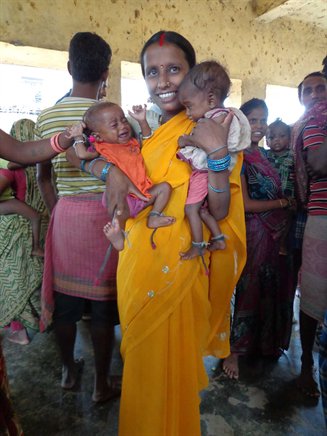
अनुसंधान की आवश्यकता
बाल कुपोषण समाज के स्वास्थ्य की एक प्रमुख चिंता का विषय है - बच्चे की मौत के ४५% में कुपोषण एक मुख्य कारण है.
कुपोषित बच्चों की संख्या बिहार और भारत के अन्य उत्तरी राज्यों के गरीब क्षेत्रों में सबसे अधिक है.
अतह् बच्चों में कुपोषण को कम करने के साधनो का मूल्यांकन एवं अध्ययन की आवश्यकता है. रोज़ीरोटी माइक्रोफाइनांस (लघु वित्त) कार्यक्रम ग्रामीण समुदायों की आर्थिक समरिद्धी बढ़ता है और उनके बच्चों के पोषण में सुधार कर सकता है. यह बच्चों के स्वास्थ्य में सुधार के पारंपरिक तरीकों के लिए एक विकल्प प्रदान कर सकता है और आसानी से एक बड़े क्षेत्र पर सबसे गरीब समुदायों को मदद् करने के लिए बढ़ाया जा सकता है.
शोध के लिए प्राथमिक सवाल
क्या स्वयं सहायता समूहों के माध्यम से शुरू की रोज़ीरोटी लघु वित्त योजना, ५ वर्ष से कम उम्र के बच्चों के बीच गंभीर कुपोषण (ऊंचाई के अनुसार वजन के ज़ेड स्कोर) की डिग्री को कम करता है?
शोध के लिए द्वितीयक सवाल
क्या रोज़ीरोटी लघु वित्त योजना अन्य नृमितीक नापों (मध्य ऊपरी बांह की परिधि, उम्र के अनुसार ऊंचाई का ज़ेड स्कोर, उम्र के अनुसार वजन का ज़ेड स्कोर) में सुधार करता है?
क्या रोज़ीरोटी लघु वित्त योजना ५ साल से कम उम्र के बच्चों के मृत्यु दर में परिवर्तन करता है?
क्या रोज़ीरोटी लघु वित्त योजना टीकाकरण का दर और स्कूल में बच्चों की उपस्थिति को प्रभावित करता है?
रोज़ीरोटी लघु वित्त योजना बच्चों की उत्तरजीविता और पोषण की स्थिति को किन माध्यमों से प्रभावित करता है?
कार्यक्रम
गांवों में बहुत गरीब लोगों की मदद करने के लिए, रोज़ीरोटी एक अभिनव लघु वित्त योजना है. शुरुआत में, सी.पी.एस.एल के कर्मचारी महिलाओं को स्वयं सहायता समूह (एसएचजी) के बारे में विचार करने और समूह शुरू करने के गठन में समर्थन करते हैं. महिलाओं को बचत में योगदान (२ रूप्या ४० पैसा प्रति सप्ताह) करने के लिए प्रोत्साहित किया जाता है. कम से कम ५ साप्ताहिक बैठकों में भाग लेने के बाद महिलाएें ऋण की हकदार बनतीं हैं. पहले महिलाएें अपनी बचत से ऋण लेती हैं और ३-६ महीनों के बाद सी.पी.एस.एल द्वारा बाह्य ऋण प्राप्त कर सकती हैं. समूह के सदस्यों को ऋण के लिए स्वयं सहायता समूह के सभी सदस्यों की सहमती लेनी होती है. ये ऋण (सामान्यत: पचास रूप्या पर आपातकालीन ऋण के लिए बड़ी रक़म) आमतौर पर छोटे होते हैं. समूहों की महिलाएें ऋण का अनुरोध किसी भी उद्देश्य के लिए कर सकती हैं. ऋण लेने के समय, सदस्सा लोन की अवधि आप हीं निस्चित करतीं हैं. संस्थागत ऋण का ब्याज दर १६% एे. पी.आर है.
२००१ से, सी. पी.एस.एल उत्तरी भारत में गरीबों के बीच रोज़ीरोटी लघु वित्त योजनाओं को चलाने में बेहद सफल रहा है. २०११ तक ४,१०० स्वयं सहायता समूहों में लगभग ४०,००० सदस्य (अधिकतर महिला) हैं. ६०-८०% ऋण सदस्यों द्वारा निर्धारित समय के भीतर बरामद हो रहा है.
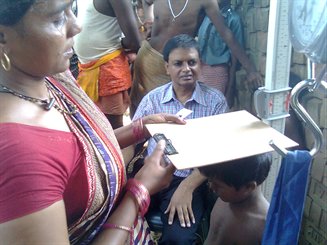
शोद्ध प्रनाली
रीच परीरोजना एक क्लस्टर नियंत्रित शोद्ध अध्धयन के रूप में बनाया गया है.
प्रतीभागी टोले दो भाग में विभाजित किये जायेंगे. विभाजन टोलों की जनसंख्या, आर्थिक स्धिति और कृषि क्षेत्र के अनुसार किया जाएगा. हर टोली अपने जोंड़े से कम से कम १५ की. मी. दूर होगा.
अग्रगामी परियोजना के लिये महिलाऔं की अवगत सहमति वीडियो रिकाॅडिंग के द्वारा ली गई है. रीच परियोजना में इसी प्रकार से सहमति ली जाएगी.
स्वास्थ्य और पोषण के परिणामों के माप शोद्ध की शुरूअात में, अध्धयन के दौरान (७ महिने, १७ महिने, २७ महिने) और अन्त में किये जायेंगे. जो बच्चे अध्धयन के आरंभ में ५ वर्ष से कम ऊमर् के हैं या जिन का जन्म अध्धयन की अवधि के दौरान होता है, वह सभी शोद्ध में शामिल किये जायेंगे.
आर्थिक, सामाजिक और गुणात्मक परिणाम
रोज़ीरोटी लघु वित्त योजना किस प्रकार बच्चों की उत्तरजीविता और पोषण की स्थिति को प्रभावित कर सकता है, ईस के अध्धयन के लिये दो गुणात्मक शोधकर्ता (एक मानव विज्ञानी और एक अर्थशास्त्री काम करेंगे. ईस के लिये वे निम्नलिखित माध्यमों पर शोद्ध करेंगे और उनकी तुलना दोनों भाग के टोलों के बीच करेंगे:
- जनसांख्यिकी
- पोषण (स्तनपान, पूरक आहार, भोजन की उपलब्धता) स्वास्थ्य (टीकाकरण, बचपन की बीमारियों के लिए देखभाल की मांग, बीमारियों की रोकथाम)
- घरेलू आय
- महिला सशक्तिकरण - "महिला सशक्तिकरण के कृषि सूचकांक" प्रश्नावली का प्रयोग कर निम्नलिखित पर डेटा इकट्ठा किया जायेगा:
- जनसांख्यिकी (जाति सहित)
- घर के वित्त का ज्ञान
- बच्चों की उम्र और स्कूल में उपस्थिति
- भूमि स्वामित्व और शेयर फसल
- घर स्वामित्व और हालत
- पशुधन, घरेलू उपकरणों, वाहनों और कृषि उपकरणों का स्वामित्व
- इंदिरा आवास या जननी सुरक्षा (प्रसूति) योजनाओं का उपयोग
- स्थानीय साहूकार और मौजूदा ऋण का उपयोग
- घरेलू हिंसा का अनुभव
- हाल के आपातकालीन संपत्ति की बिक्री
संभावित प्रभाव
परम्परागत पोषण संबंधी कार्यक्रम अक्सर समाज के सबसे गरीब अनुभाग को लाभ नहीं करते. रोज़ीरोटी इस समूह की महिलाओं को लक्षित करता है - रोज़ीरोटी कार्यक्रम में भाग लेने वाली ६२% महिलाएँ अनुसूचित जाति से हैं और ७०% गरीबी रेखा से नीचे हैं. अगर रोज़ीरोटी कार्यक्रम गरिबों के बच्चों के पोषण में सुधार करता है तो इसे आगे बढ़ाया जा सकता है और गरीब बच्चों के स्वास्थ्य और पोषण में सुधार लाने के लिए पोषण संबंधी कार्यक्रमों के साथ इस्तेमाल किया जा सकता है.
भारत में सीखा सबक अन्य कम और मध्यम आय वाले देशों के लिए प्रासंगिक हो सकता है
